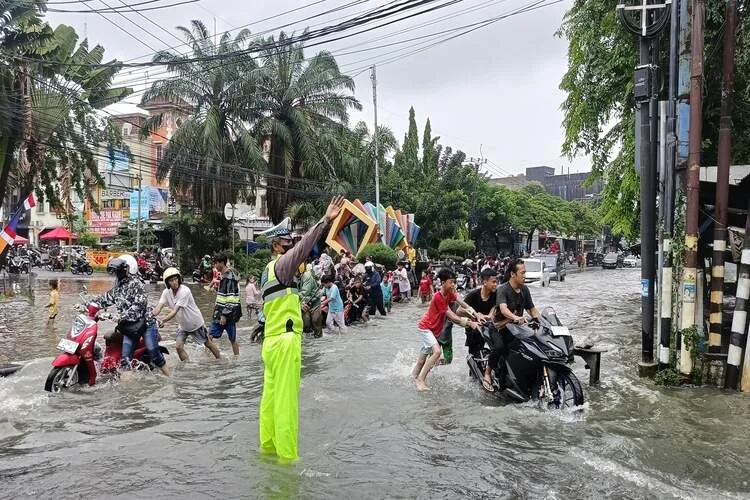
As the planet becomes more and more interconnected, the likelihood of systemic risks rises. But what are they – and should we be worried?
By
Risks are present all the time in society. Whether it be singular or multiple risks realised at the same time, there are plenty of environmental and social harms that can come to fruition.
But now, thanks to new technologies that can cause harm, an ever-growing interconnected community fostered by social media, and the planet’s growing environmental footprint beyond safe limits, the rate at which risks can grow – especially systemic risks – is higher than ever before. But what exactly are they – and should we be worried about them?
What are systemic risks?
Systemic risks are those which affect the systems that society relies upon, such as the environment, health and transport. These types of risks can cross between sectors, regions and systems in what is known as a ‘cascading effect’, leading to devastating and widespread impact.
Often, they are slow to start and hard to predict – and can occur either from within a sector or outside it. Historically, studies have focused upon systemic risks to the financial sector and banks, but there are a whole host of systemic risks that can impact all corners of the globe.

Examples include the COVID-19 pandemic and the global financial crisis of 2008. Both of these disrupted many global systems – healthcare, economies and food chains – and amplified issues in supply chains, education and social security. Climate change is perhaps one of the biggest systemic risks that the planet faces too. It can affect food production and impede water access, lead to public health impacts and even cause migration and conflicts: all of which are interconnected factors that need to be considered in the fullest view.
Because they are so complex, systemic risks are often irreversible once a tipping point is crossed, and they possess more potential to cause harm than single risks alone.
Why are they hard to tackle?
There are many reasons as to why systemic risks are difficult to tackle. Perhaps most overarchingly is the complexity of them. The cause of systemic risks is hard to pinpoint, and so it can be easy to adopt a ‘wait and see’ strategy that either flattens out any complexity in discussions, or entirely eliminates any context that is inconvenient.
But it is pivotal that communication about these risks are made clear to both the public and policymakers alike. Conveying the message that it matters now even if the effects of risks only occur in the future is key.

Systemic risks are also hard to tackle due to insufficient data collection. Often, risk assessments focus on a particular nation or sector, addressing issues and ways to mitigate these risks. But systemic risks are far larger, and more interconnected than that.The views of historically underrepresented groups – the Global South, women, youth and Indigenous Peoples to name a few – are pivotal to record, but are often neglected in many surveys and records. With these voices incorporated, it becomes easier to paint a clearer picture of how systemic risks can arise.

For example, traditional knowledge around agricultural practices in farming could be key to help food systems become more sustainable. Using Indigenous knowledge alongside scientific data has also been shown to improve understanding of how ecosystems change in rivers, while incorporating the views of youth and young adults boosts organisations’ performance and outcomes.
As well as this, the complex nature of systemic risks means funding is often forgone to instead focus on more disciplinary and clear-cut issues. Governments and organisations can easily focus on short-term, single-issue crises but as a result can overlook a more close analysis that would highlight the relationship between crises that occur very quickly after one another. If funding bodies opened up funding flows to analyse systemic risk, the root causes of complex problems may be solved.
Long-term thinking has occurred more frequently in recent times, notably after COVID-19 pandemic which tackled both the specific health crisis at hand as well as the need to ‘build back better’ in economies, healthcare systems and vaccination roll-out programmes. But more is certainly needed to be done to implement such thinking into business reporting, media cycles and decision-making.
Looking to the future
As more governmental bodies, policymakers and sectors become aware of the interconnected nature of various risks, the future does paint a brighter picture in tackling them before they turn into full-blown crises.
In the EU, the recently formed Systems Transformation Hub seeks to find systemic solutions for Europe, and to help member states during multiple crises. Terminology is also being developed to help create a shared language around systemic risks.

Many sectors are also now carrying out risk assessments that are more complex and nuanced. In the insurance sector, reinsurers including Swiss Re and Munich Re offer natural catastrophe modelling that identifies the likelihood and severity of natural hazards, as well as their financial impact.
The annual Lancet Countdown is used in healthcare in order to monitor how multiple health implications of climate change are progressing, as well as assessing how governments are delivering climate change commitments under the Paris Agreement.
In an environmental context, climate change and biodiversity risk assessments are now often including estimates of economic loss with various climate-warming scenarios, as well as assessments of actions to adapt to such warming. These projects include China’s National Climate Change Adaptation Strategy 2035, which seeks to strengthen its climate change modelling, as well as the European Environment Agency’s 2024 assessment of climate risks.



